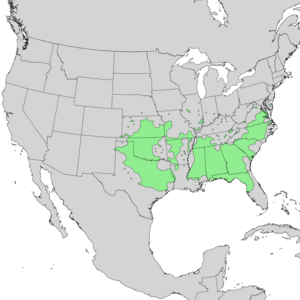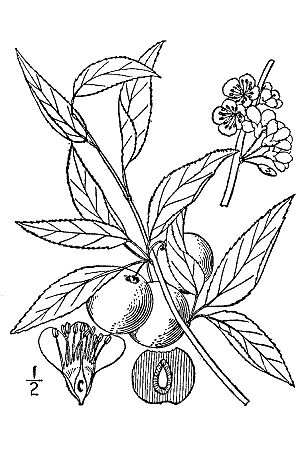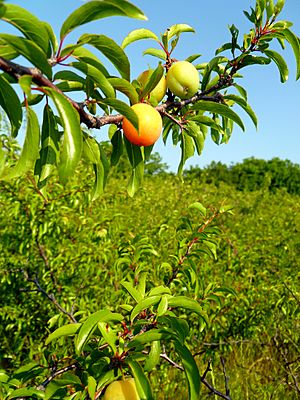Prunus angustifolia facts for kids
Quick facts for kids Prunus angustifolia |
|
|---|---|
 |
|
| Conservation status | |
| Scientific classification | |
| Genus: |
Prunus
|
| Species: |
angustifolia
|
 |
|
| Natural range of Prunus angustifolia | |
| Synonyms | |
|
|
The Chickasaw plum (scientific name: Prunus angustifolia) is a type of plum tree found in North America. It is also known by other names like Cherokee plum or sand plum. Long ago, Native Americans were the first to grow this tree. The name Prunus is the old name for European plums. The word angustifolia means "narrow leaves," which describes the shape of its leaves.
Contents
What the Chickasaw Plum Looks Like
The Chickasaw plum tree usually grows about 12 to 20 feet (3.5 to 6 meters) tall. It can spread out 15 to 20 feet (4.5 to 6 meters) wide. This tree has a unique, somewhat uneven shape. Its bark is scaly and almost black. The branches are reddish and have small, sharp side branches that look like thorns.
In spring, from February to May, the tree gets small white flowers. These flowers are about 0.3 to 0.4 inches (8 to 10 millimeters) wide. Each flower has five white petals. After the flowers, small red plums grow. These plums can be up to 1 inch (25 millimeters) long. They look a bit like cherries. The plums are quite tart when they are young. They become sweet when they are fully ripe in late summer.
This plum tree does not need a lot of water. It grows best in dry, sandy, or loose soil. It likes sunny places or areas with some shade. In sunny spots, the tree will grow very thick. In partly shaded areas, it will be thinner and more spread out. It can be hard to tell the Chickasaw plum apart from another tree called Prunus umbellata. They can even mix together easily.
Where Chickasaw Plums Grow
The Chickasaw plum grows in many parts of the eastern and central United States. You can find it from Florida all the way west to New Mexico and California. It also grows north to Nebraska, Illinois, and New Jersey. There are even a few small groups of these trees in northern Michigan.
These trees like to grow in dry, sandy soils. You can often see them in open forests, along the edges of woodlands, or in clearings. They also grow in grasslands, prairies, meadows, and along roadsides. In the state of New Jersey, the USDA lists the Chickasaw plum as an endangered species. This means it is rare there and needs protection.
How Chickasaw Plums Are Used
Chickasaw plum trees bloom early in the spring. This happens before many other plants start to flower. They also do not need much care. Because of this, people often plant them in gardens for their beauty. You can often see them growing wild along highways, especially in the southern United States.
The fruit of the Chickasaw plum is eaten by many different animals. The leaves and branches also provide good places for birds to build their nests. The plums are about 1/2 inch (12 millimeters) big. They change from red to yellow when they are fully ripe. You can eat them raw, and they are often used to make tasty jellies.
The Chickasaw plum also has pretty bark, small leaves, and thin branches. Because of these features, it is sometimes used for bonsai. Bonsai is the art of growing small trees in pots.
Animals That Use Chickasaw Plums
Many insects use the Chickasaw plum tree as a host plant. This means that the young insects, called larvae, eat the leaves of the tree. Some of the moths and butterflies that use this tree include:
- the black-waved flannel moth
- the blinded sphinx
- the cecropia moth
- the coral hairstreak
- the elm sphinx
- the hummingbird clearwing moth
- the imperial moth
- the Io moth
- the polyphemus moth
- the promethea silkmoth
- the red-spotted purple
- the small-eyed sphinx
- the spring azure
- the striped hairstreak
- the tiger swallowtail
These trees are found around Beaver County, Oklahoma, and Lipscomb County, Texas.
Images for kids
See also
 In Spanish: Prunus angustifolia para niños
In Spanish: Prunus angustifolia para niños







